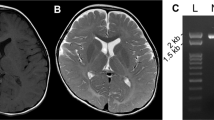Abstract
A locus for X–linked hydrocephalus (HSAS), which is characterized by mental retardation and enlarged brain ventricles, maps to the same subchromosomal region (Xq28) as the gene for neural cell adhesion molecule L1. We have found novel L1 mRNA species in cells from affected members of a HSAS family containing deletions and insertions produced by the utilization of alternative 3′ splice sites. A point mutation at a potential branch point signal in an intron segregates with the disease and is likely to be responsible for the abnormal RNA processing. These results suggest that HSAS is a disorder of neuronal cell migration due to disruption of L1 protein function.
This is a preview of subscription content, access via your institution
Access options
Subscribe to this journal
Receive 12 print issues and online access
$209.00 per year
only $17.42 per issue
Buy this article
- Purchase on Springer Link
- Instant access to full article PDF
Prices may be subject to local taxes which are calculated during checkout
Similar content being viewed by others
References
McKusick, V.A. Mendelian Inheritance in Man: Catalogs of Autosomal Dominant, Autosomal recessive and X-linked Phenotypes (John Hopkins University Press, Baltimore, 1988).
Willems, P.J., Brouwer, O.F., Dijkstra, I. & Wilmink, J. X-linked hydrocephalus. Am. J. med. Genet. 27, 921–928 (1987).
Willems, P.J. et al. Assignment of X-linked hydrocephalus to Xq28 by linkage analysis. Genomics 8, 367–370 (1990).
Winter, R.M., Davies, K.E., Bell, M.V., Huson, S.M. & Patterson, M.N. MASA syndrome: further clinical delineation and chromosomal localisation. Hum. Genet. 82, 367–70 (1989).
Schrander-Stumpel, C., Legius, E., Fryns, J.P. & Cassiman, J.J. MASA syndrome: new clinical features and linkage analysis using DNA probes. J. med. Genet. 27, 688–692 (1990).
Willems, P.J., Vits, L. & Raemaekers, P. Further linkage of X-linked hydrocephalus to Xq28. Cytogenet. cell. Genet. 58, 2090 (1991).
Poustka, A. et al. Physical map of human Xq27–qter: localizing the region of the fagile X mutation. Proc. natn. Acad. Sci. U.S.A. 88, 8302–8306 (1991).
van Oost, B.A. et al. In Mapping of Genes and DNA-Markers in Xq28 with Somatic Cell Hybrids 1 (IIGB Press, Amalf, Italy, 1992).
HIavin, M.L. & Lemmon, V. Molecular structure and functional testing of human L1. Genomics 11, 416–423 (1991).
Rosenthal, A., MacKinnon, R.N. & Jones, D.S.C. PCR Walking from microdissection clone M54 Identifies three exons from the human gene for the neural cell adhesion molecule L1 (CAM-L1). Nucl. Acids Res. 19, 5395–5401 (1991).
Kowitz, A. et al. Expression and function of the neural cell adhesion molecule L1 in mouse leukocytes. Eur. J. Immunol. 22, 1199–1205 (1992).
Sharp, P. Splicing of messenger RNA precursors. Science 235, 767–771 (1987).
Smith, S.B., Aldridge, P.K. & Callis, J.B. Observation of individual DNA molecules undergoing gel electrophoresis. Science 243, 203–206 (1989).
Grumet, M. Cell adhesion molecules and their subgroups in the nervous system. Curr. Op. Neurobiol. 1, 370–376 (1991).
Lemmon, V., Farr, K.L. & Lagenaur, C. L1-mediated axon outgrowth occurs via a homophilic binding mechanism. Neuron 2, 1597–1603 (1989).
Kuhn, T.B., Stoeckli, E.T., Condrau, M.A., Rathjen, F.G. & Sonderegger, P. Neurite outgrowth on immobilized axonin-1 is mediated by a heterophilic interaction with L1 (G4). J. cell. Biol. 115, 1113–1126 (1991).
Legouis, R. et al. The candidate gene for the X-linked Kallmann syndrome encodes a protein related to adhesion molecules. Cell 67, 423–435 (1991).
Landmesser, L., Dahm, L., Schultz, K. & Rutishauser, U. Distinct roles for adhesion molecules during innervation of embryonic chick muscle. Devl. Biol. 130, 645–670 (1988).
Bach, I. et al. Microdeletions in patients with gusher-associated, X-linked mixed deafness (DFN3). Am. J. hum. Genet. 50, 38–44 (1992).
Rosenthal, A. & Charnock-Jones, D.S. New protocols for dye terminator sequencing. DNA Sequence (in the press).
Author information
Authors and Affiliations
Rights and permissions
About this article
Cite this article
Rosenthal, A., Jouet, M. & Kenwrick, S. Aberrant splicing of neural cell adhesion molecule L1 mRNA in a family with X–linked hydrocephalus. Nat Genet 2, 107–112 (1992). https://doi.org/10.1038/ng1092-107
Received:
Accepted:
Issue Date:
DOI: https://doi.org/10.1038/ng1092-107
This article is cited by
-
A recurrent synonymous L1CAM variant in a fetus with hydrocephalus
Human Genome Variation (2024)
-
Ptpn20 deletion in H-Tx rats enhances phosphorylation of the NKCC1 cotransporter in the choroid plexus: an evidence of genetic risk for hydrocephalus in an experimental study
Fluids and Barriers of the CNS (2022)
-
Genomics of human congenital hydrocephalus
Child's Nervous System (2021)



